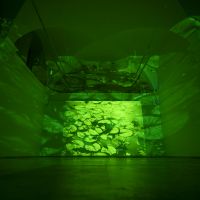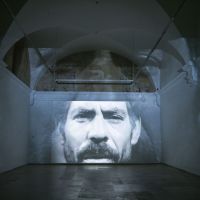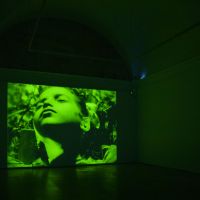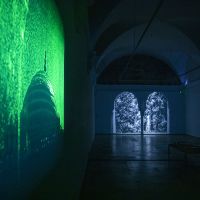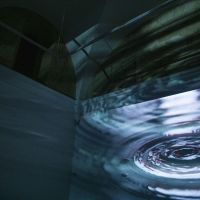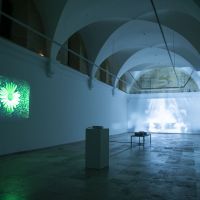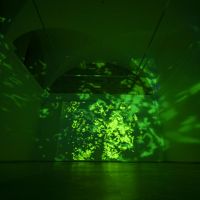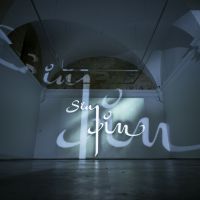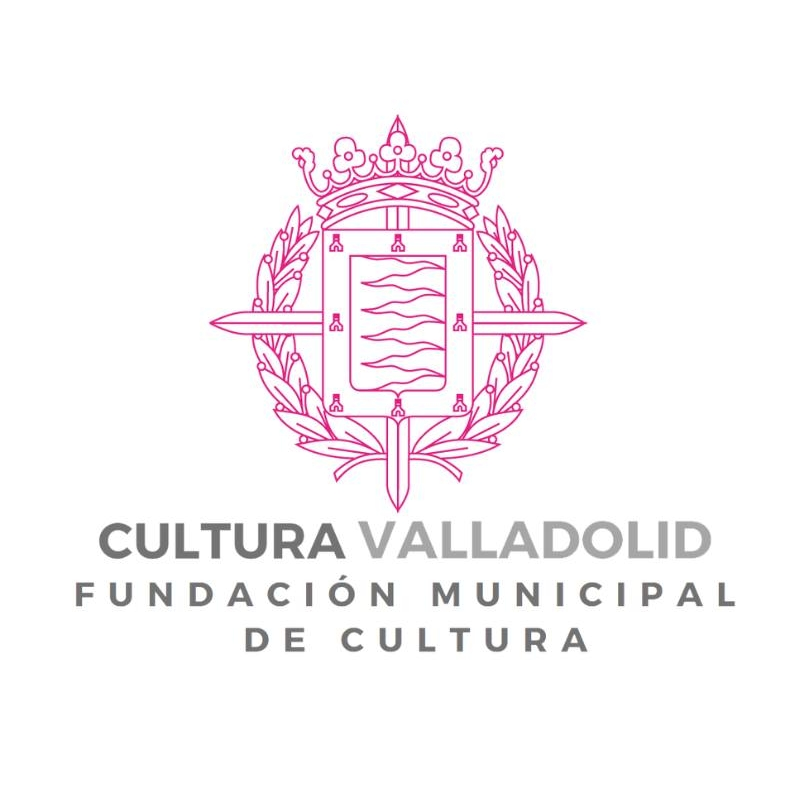TRASCENDENCIA DE VAL DEL OMAR
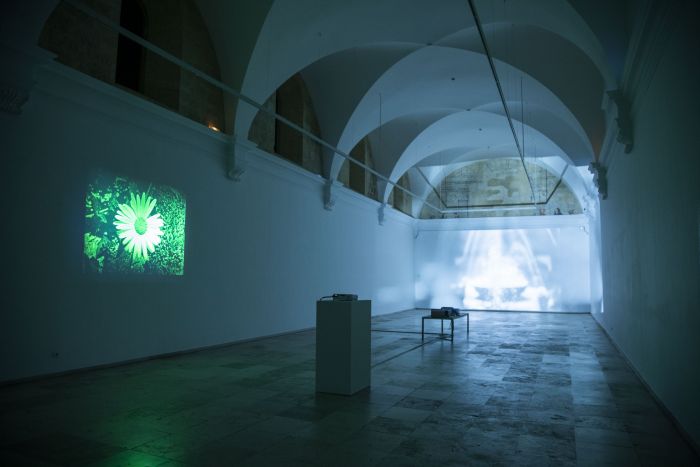
[English version below]
La exposiciÃģn Trascendencia de Val del Omar estÃĄ formada por cuatro pelÃculas pertenecientes a dos de los periodos mÃĄs relevantes de la producciÃģn del cineasta granadino, o âcinemistaâ, como el preferÃa denominarse. Estos dos periodos son la dÃĐcada de los treinta y la de los cincuenta, dos momentos en los que se fraguaron sus filmes mÃĄs relevantes. A la primera etapa pertenecen Fiestas Cristianas/Fiestas paganas, VibraciÃģn de Granada y PelÃcula familiar, realizadas todas ellas hacia mediados de la dÃĐcada de los treinta y en el entorno de las Misiones PedagÃģgicas, en las que Val del Omar participÃģ activamente. En la segunda etapa, ya en los cincuenta, Val del Omar rodÃģ Aguaespejo granadino, una de sus obras legendarias, que a la postre integrarÃa el TrÃptico Elemental de EspaÃąa del que tambiÃĐn formarÃan parte Fuego en Castilla, rodada en el Museo Nacional de Escultura, y AcariÃąo Galaico. En el tramo final de su carrera y hasta su muerte en 1982, se dirigiÃģ a una mayor experimentaciÃģn tÃĐcnica en busca de nuevas metodologÃas en torno a la luz, la forma y el sonido, elementos estructurales de su quehacer.
La presencia de Val del Omar en el Museo Patio Herreriano se desdobla a su vez en dos ÃĄmbitos diferentes que dan cuenta de la naturaleza poliÃĐdrica de su obra. VibraciÃģn de Granada y Aguaespejo granadino pueden verse en la Sala 9, el lugar que hasta hace poco ocuparon las pinturas de Soledad Sevilla basadas en sus conocidos esquemas ornamentales y en su relaciÃģn con la luz. Es interesante recordar que Soledad Sevilla pasÃģ muchos aÃąos en Granada, donde fue profesora de la Facultad de Bellas Artes, y ha vivido y trabajado ahà muchos aÃąos, inspirÃĄndose en ella para realizar algunas de sus piezas mÃĄs aclamadas. En el espacio contiguo, la Capilla de los Condes de FuensaldaÃąa, permanece su instalaciÃģn âDe la luz del sol y de la lunaâ, realizada con hilos de algodÃģn, una pieza que acompaÃąarÃĄ durante estos meses a las dos pelÃculas de Val del Omar sobre Granada, una ciudad que ÃĐl mismo describÃa como âla eterna frontera de la noche a la maÃąanaâ.
En VibraciÃģn de Granada, filmada en 1935, se ven ya los mimbres de Aguaespejo granadino, rodada 20 aÃąos mÃĄs tarde: un afecto especial por el agua en sus variables manifestaciones; una reflexiÃģn estÃĐtica que nace del encuentro entre la luz y la arenisca roja, las sombras yendo y viniendo en rutinarias secuencias que definen atauriques y collarinos, con las faldas escarpadas de Sierra Nevada de fondoâĶ El âAguaespejoâ, por su parte, con su imagen desbordando el marco, lleva estas pautas iniciales a otra dimensiÃģn mÃstica, con la incorporaciÃģn de referencias vegetales y animales en las que resuenan los ecos de la decoraciÃģn nazarÃ. El sonido se desliza en el metraje desarrollando arritmias paralelas a aquÃĐllas otras que tambiÃĐn definen las secuencias de imÃĄgenes. Si bien âAguaespejoâ es muy posterior, en ella permanecen todavÃa vestigios de la aproximaciÃģn documental, humanista y utÃģpica de las Misiones.
En otro ÃĄmbito, el de la exposiciÃģn de Piedad Isla. Un testimonio fotogrÃĄfico en las Salas 1 y 2, Fiestas Sagradas/Fiestas paganas y Pelicula familiar, filmadas, como la âVibraciÃģnâ, a mediados de los aÃąos treinta, tienen un mismo caracter documental. Las âfiestasâ reÚnen metraje rodado en Murcia, Lorca y Cartagena que se detiene ante diferentes formas rituales de la Semana Santa y de las fiestas de la Primavera, en un elogio de la luz y una clamorosa revelaciÃģn de las pasiones colectivas. La PelÃcula familiar, por el contrario, evoca un ambiente mÃĄs intimista, protagonizado por el propio Val del Omar, su mujer y sus hijos en diferentes situaciones, todas ellas, sin embargo, unidas por el asombro que produce cuanto de incipiente y prometedor se halla en el cine y en la vida.
Transcendence of Val del Omar
Patio Herreriano Museum
The exhibition entitled Transcendence of Val del Omar consists of four films belonging to two of the most significant periods in the production of the filmmaker from Granada, or âcinemistâ, as he preferred to call himself. The two periods are the 1930s and the 1950s, two moments in which his most relevant films were made. To the first stage belong Christian Festivities/Pagan Festivities, The Pulsation of Granada and Family Film, all of them made in the mid-1930s and in the context of the Pedagogical Missions, in which Val del Omar took an active part. In the second stage, in the 1950s, Val del Omar filmed Granada Watermirror, one of his legendary pieces, which would later form part of the Elementary Triptych of Spain, which also included Fire in Castile, filmed at the National Sculpture Museum, and Galician Caress. Towards the end of his career and right up to his death in 1982, he moved towards greater technical experimentation in search of new methodologies based on light, form and sound, the structural elements of his work.
Val del Omarâs presence at the Museo Patio Herreriano is in turn divided into two different areas that reflect the multifaceted nature of his work. The Pulsation of Granada and Granada Watermirror can be seen in Room 9, the place taken up until recently by Soledad Sevillaâs paintings based on her well-known ornamental schemes and her relationship with light. It is interesting to remember that Soledad Sevilla spent many years in Granada, where she taught at the Faculty of Fine Arts; she lived and worked there for many years, drawing inspiration for some of her most acclaimed pieces. In the adjoining space, the Counts of FuensaldaÃąa Chapel, remains her installation âOf Sunlight and Moonlightâ, made with cotton thread, a piece that over the coming months will accompany the two films by Val del Omar about Granada, a city that he himself described as the âeternal borderline between the night and the morningâ.
In The Pulsation of Granada, filmed in 1935, we can already see the makings of Granada Watermirror, filmed 20 years later: a special affection for water in its variable manifestations, an aesthetic reflection born of the encounter between light and red sandstone, the shadows coming and going in routine sequences defining atauriques and neckings, with the steep slopes of the Sierra Nevada in the background... The âWatermirrorâ, with its image flowing outside the frame, takes these initial guidelines to another mystical dimension, with the incorporation of plant and animal references in which echoes of Nasrid decoration resound. The sound slips into the footage, developing arrhythmias parallel to those that also define the image sequences. Although âWatermirrorâ was filmed much later, traces of the documentary, humanist and Utopian approach of the Missions still remain in it.
In another area, the exhibition entitled Piedad Isla â A Photographic Testimony in Rooms 1 and 2, Christian Festivities/Pagan Festivities and Family Film, filmed, just like âPulsationâ, in the mid-1930s, enjoy the same documentary nature. The âfestivitiesâ include footage filmed in Murcia, Lorca and Cartagena, focusing on the different ritual forms of Easter and Spring festivals, praising light and resoundingly revealing collective passions. Family Film, on the other hand, evokes a more intimate atmosphere, starring Val del Omar himself together with his wife and children in different situations, all of them, however, united by the astonishment produced by all that is incipient and promising in films and life.

